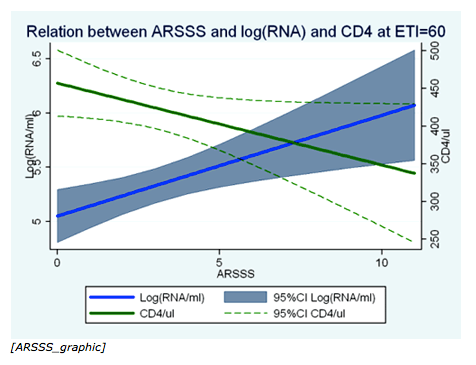 |
 |
 |
| |
Acute Retroviral Syndrome Score Correlates With Signals of Progression
|
| |
| |
7th IAS Conference on HIV Pathogenesis, Treatment and Prevention, June 30-July 3, 2013, Kuala Lumpur
Mark Mascolini
A simple 6-item score for people with the acute retroviral syndrome correlated with viral load and CD4 values that typically predict the clinical course of HIV infection [1]. University of Zurich researchers proposed that the score can help determine which people with acute HIV infection need immediate antiretroviral therapy.
The best way to manage acute HIV infection remains open to question, with studies of immediate treatment yielding varying results. Researchers working with the Zurich Primary HIV-1 Infection Study hypothesized that an acute retroviral syndrome severity score (ARSSS) consisting of basic clinical and lab values may help predict which patients diagnosed with acute infection will have a more rapid disease course.
The Zurich Primary HIV-1 Infection Study includes 290 longitudinally enrolled people with documented primary HIV infection. The ARSSS consists of six parameters assigned a score of 3 or 1:
-- Severe neurologic symptoms: 3
-- Inpatient treatment: 3
-- Age 50 or older: 1
-- Fever (temperature at or above 38 C): 1
-- ALT or AST at or above 30 U/L: 1
-- Thrombocytopenia (platelets below 150 g/L): 1
Thus the maximum score is 10 and the minimum is 0. The Zurich team used linear regression models to assess the impact of the ARSSS on baseline viral load, baseline CD4 count, and viral set point (the level at which HIV RNA settles after the initial spike during primary infection).
The 290-person cohort averaged 36 years in age and included 271 men (93%) and 19 women. While 242 people (83%) had acute HIV infection, 48 were diagnosed with recent infection. Most people (77%) were infected with HIV-1 subtype B.
The study group's ARSSS averaged 2.89 (range 0 to 10). People with a higher ARSSS had a significantly lower baseline CD4 count (P = 0.03) and a significantly higher viral load (P = 0.001). Linear regression analysis determined that every 1 point higher ARSSS corresponded with a 0.17-log higher baseline viral load and a 12-cell lower baseline CD4 count.

Among 64 people who did not start antiretroviral therapy, those with a higher ARSSS had a significantly higher viral load set point (P = 0.029). Among 40 people who started antiretroviral therapy early in the course of infection and had a later planned treatment interruption, ARSSS did not correlate with viral load set point (P = 0.28).
The researchers concluded that "the novel ARSSS is a simple clinical score that correlates with surrogate markers of HIV-1 disease progression." They proposed that "patients with a high ARSSS should strongly be considered for immediate antiretroviral therapy."
Reference
1. Braun DL, Kouyos R, Grube C, et al. A novel acute retroviral syndrome severity score predicts surrogate markers associated with HIV-1 disease progression. 7th IAS Conference on HIV Pathogenesis, Treatment and Prevention, June 30-July 3, 2013, Kuala Lumpur. Abstract TUPE252.
|
| |
|
 |
 |
|
|